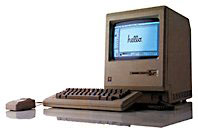Mac Musings
The Significance of the 512K Fat Mac
Daniel Knight - 2004.09.10
It was 20 years ago today, Apple Computer taught the Mac to play by offering the first upgrade to the original 128K Macintosh.
The first Mac was a breakthrough in many ways, but 128 KB turned out to be a lot less RAM than most users needed. For a start, the memory mapped display used 21 of those 128 KB, and the Mac OS plus your application and working file(s) had to reside in the remaining 107 KB.
Fortunately, the original Macintosh had been designed to work with 256 Kb memory chips, not just the 64 Kb chips used when the computer was first released, so it wasn't a big engineering feat to create the 512K Fat Mac, the first Mac to ship with enough memory to become really useful.
Yes, you read that right. In fact, the original 128 KB model was so limited that Steve Jobs used a 512 KB prototype to demonstrated what the Mac could do at it's introduction. The things he wanted to do at the unveiling simply couldn't be done within the memory constraints of the shipping machine. (With RAM prices where they were, a 512 KB Macintosh would have been prohibitively expensive earlier in 1984.)
More memory was the only real difference between the Fat Mac and its 128 KB predecessor. They both shared the same 1-bit b&w display, enclosure design, keyboard, mouse, 400 KB single-sided floppy, and ports on the rear.
 But 512 KB was a lot more usable
memory than 128 KB. The screen used 21 KB of RAM, so available
memory was 491 vs. 107 KB - almost five times as much on the Fat
Mac! Mac OS
1.1 weighed in at 198 KB, so the 128 KB model had to access
the floppy more often for system files, while the Fat Mac had
enough RAM for the entire Mac OS. (The Finder itself used 40-50 KB
of RAM.)
But 512 KB was a lot more usable
memory than 128 KB. The screen used 21 KB of RAM, so available
memory was 491 vs. 107 KB - almost five times as much on the Fat
Mac! Mac OS
1.1 weighed in at 198 KB, so the 128 KB model had to access
the floppy more often for system files, while the Fat Mac had
enough RAM for the entire Mac OS. (The Finder itself used 40-50 KB
of RAM.)
For programs that weren't hard-wired for the original Mac's 128 KB memory, the Fat Mac created room for bigger spreadsheets, longer documents, and so on. It also made possible the Switcher, a program that allowed Mac users to have two to four programs in memory and switch between them.
512 KB was enough to turn the Macintosh from a cute proof-of-concept machine into the computer that would revolutionize the publishing industry. Aldus PageMaker 1.0 became the Mac's killer app in July 1985, and there's just no way it could have been possible without a lot more than 128 KB of memory.
The Fat Mac would remain Apple's flagship model until the Mac Plus was introduced in January 1986 and made 1 MB of RAM (expandable to 4 MB), double-sided 800K floppies, and a SCSI port the norm.